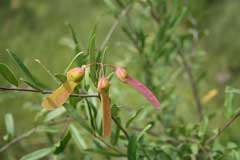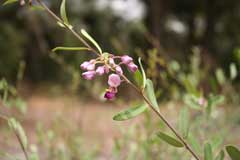 |
|
http://commons.wikimedia.org/wiki/User:Marco_Schmidt |
 |
| http://commons.wikimedia.org/wiki/User:Marco_Schmidt |
Translate this page:
Summary
Small to medium-sized tree, measuring between 6 and 12 meters tall. The species suffers from over-harvesting for use in local medicines. Periodic droughts and bush fires are also a hazard for the propagation of this tree. The plant is commonly gathered from the wild for medicinal use and also as a food and source of materials.
Physical Characteristics

 Securidaca longipedunculata is a deciduous Tree growing to 6 m (19ft 8in).
Securidaca longipedunculata is a deciduous Tree growing to 6 m (19ft 8in).
See above for USDA hardiness. It is hardy to UK zone 10. The species is hermaphrodite (has both male and female organs).
Suitable for: light (sandy), medium (loamy) and heavy (clay) soils. Suitable pH: mildly acid, neutral and basic (mildly alkaline) soils. It can grow in semi-shade (light woodland) or no shade. It prefers moist soil.
UK Hardiness Map
US Hardiness Map
Synonyms
Plant Habitats
Cultivated Beds;
Edible Uses
Edible Parts: Leaves
Edible Uses:
Young leaves - cooked[418
]. Eaten as a vegetable or in sauces[303
, 418
].
References More on Edible Uses
Medicinal Uses
Plants For A Future can not take any responsibility for any adverse effects from the use of plants. Always seek advice from a professional before using a plant medicinally.
Antiinflammatory Antitussive Laxative Odontalgic
The plant has 100 medicinal uses[214]. The violet tree is the most popular of all the traditional medicinal plants in South Africa, where it is used for almost every conceivable ailment[295
]. It is also popularly used throughout its range. The roots are extremely poisonous, smell like wintergreen oil and contain methyl salicylate which may partly indicate why they have a wide diversity of uses, such as arrow poison in some parts of Africa including West Africa[295
]. The plant is said to have 100 medicinal uses[214
].
The roots and bark are taken orally either powdered or as infusions for treating chest complaints, headache, inflammation, abortion, ritual suicide, tuberculosis, infertility problems, venereal diseases and for constipation[295
]. Toothache can also be relieved by chewing the roots[295
]. Mixed roots of the violet tree and dwarf custard apple are used to treat gonorrhoea. Powdered roots or wood scrapings are used to treat headache by rubbing them on the forehead, while infusions from the roots are used to wash tropical ulcer[295
]s. In Limpopo, the vhaVenda people use roots for mental disorders and as protection against children's illness during breastfeeding[295
]. It is also believed that many African people use the powdered violet tree roots as a sexual boost for men[295
]. The vhaVenda people mix the powdered root with mageu (maize or sorghum beverage) and it is given to a man to drink if he is sexually weak. In Zimbabwe, the roots are used to treat people who are believed to be possessed by evil spirits, for snakebite as well as for coughs when pounded with water and salt[295
].
References More on Medicinal Uses
The Bookshop: Edible Plant Books
Our Latest books on Perennial Plants For Food Forests and Permaculture Gardens in paperback or digital formats.

Edible Tropical Plants
Food Forest Plants for Hotter Conditions: 250+ Plants For Tropical Food Forests & Permaculture Gardens.
More

Edible Temperate Plants
Plants for Your Food Forest: 500 Plants for Temperate Food Forests & Permaculture Gardens.
More

More Books
PFAF have eight books available in paperback and digital formats. Browse the shop for more information.
Shop Now
Other Uses
Basketry Charcoal Cosmetic Fibre Fuel Hedge Soap String Wood
Agroforestry Uses:
An ornamental plant, it can be grown as a hedge[774
].
Other Uses:
The bark of the roots, or the pounded seeds, can be used as a soap for washing and bleaching items[295
, 774
].
A fibre obtained from the inner bark can be used like cotton to weave a coarse cloth[308
]. The fibre obtained from young branches is particularly strong and durable[303
, 774
]. The fibre is said to be of a similar quality to flax (Linum usitatissimum)[46
]. It is also used for fishing nets, baskets and strong threads that are used to sew bark cloth[295
].
The seeds are rich in oil[774
]. It is used cosmetically or as a furniture stain[303
].
The roots at 350 ppm are 100% effective as a molluscicide[303
]..
The wood is light yellow with markedly dark growth rings. It is soft, spongy, but durable and resists the attacks of termites. It is liable to split upon drying. Of little value, it is used for poles, hut construction, brooms etc[303
, 774
].
The wood makes a good fuel and is used to make charcoal[303
, 418
, 774
]. Ornamental.
Special Uses
Attracts Wildlife Hedge
References More on Other Uses
Cultivation details
A plant of the subtropics and tropics, where it is found in a wide range of climates including hot and arid summer rainfall, and equatorial humid; at elevations up to 1,800 metres[303
]. It grows best in areas where annual daytime temperatures are within the range 20 - 30°c, but can tolerate 16 - 36°c[418
]. The plant can survive temperatures down to about 1°c[418
]. It prefers a mean annual rainfall in the range 600 - 1,000mm, but tolerates 500 - 1,300mm[418
].
Requires a sunny position[418
]. Grows best in a light, well-drained soil, succeeding even if the fertility is low[418
]. Prefers a pH in the range 5 - 7, tolerating 4.5 - 7.5[418
].
The plant can survive bush fires[418
].
The flowers are extremely attractive to birds, butterflies and insects[295
].
References Carbon Farming Information and Carbon Sequestration Information
Temperature Converter
Type a value in the Celsius field to convert the value to Fahrenheit:
Fahrenheit:
The PFAF Bookshop
Plants For A Future have a number of books available in paperback and digital form. Book titles include Edible Plants, Edible Perennials, Edible Trees,Edible Shrubs, Woodland Gardening, and Temperate Food Forest Plants. Our new book is Food Forest Plants For Hotter Conditions (Tropical and Sub-Tropical).
Shop Now
Plant Propagation
Seed - the violet tree is difficult to cultivate from seed, although some writers recommend that the seeds should be soaked thoroughly and then be planted in a sandy soil where the plants will remain, as they do not like to be disturbed[295
]. Seedlings quickly develop a deep taproot, which is fragile and easily broken. The plant often dies or does very poorly after transplanting due to damage to this taproot. Seeds should either be sown in deep, individual containers and planted out when still small, or they should be sown in situ and given appropriate care.
This tree can also be propagated by taking cuttings of the root shoots, as it does not grow well when transplanted.
Other Names
If available other names are mentioned here
violet tree, Afrikaans: krinkhout, Bambara: satene, Tswana: mmaba, Venda: mpesu.
Native Range
AFRICA: Burundi, Cameroon, Congo, Côte D‘Ivoire, Guinea, Gambia, Guinea-Bissau, Nigeria, Senegal, Angola, Mozambique, South Africa
Weed Potential
Right plant wrong place. We are currently updating this section.
Please note that a plant may be invasive in one area but may not in your area so it's worth checking.
Conservation Status
IUCN Red List of Threatened Plants Status : This taxon has not yet been assessed

Growth: S = slow M = medium F = fast. Soil: L = light (sandy) M = medium H = heavy (clay). pH: A = acid N = neutral B = basic (alkaline). Shade: F = full shade S = semi-shade N = no shade. Moisture: D = dry M = Moist We = wet Wa = water.
Now available:
Food Forest Plants for Mediterranean Conditions
350+ Perennial Plants For Mediterranean and Drier Food Forests and Permaculture Gardens.
[Paperback and eBook]
This is the third in Plants For A Future's series of plant guides for food forests tailored to
specific climate zones. Following volumes on temperate and tropical ecosystems, this book focuses
on species suited to Mediterranean conditions—regions with hot, dry summers and cool, wet winters,
often facing the added challenge of climate change.
Read More
Expert comment
Author
Fresen.
Botanical References
200
Links / References
For a list of references used on this page please go here
A special thanks to Ken Fern for some of the information used on this page.
Readers comment
© 2010, Plants For A Future. Plants For A Future is a charitable company limited by guarantee, registered in England and Wales. Charity No. 1057719, Company No. 3204567.